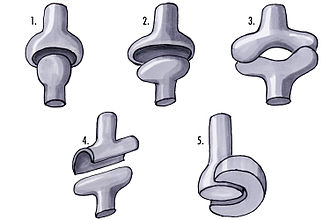| Condyloid joint | |
|---|---|
 1: Ball and socket joint; 2: Condyloid joint (Ellipsoid); 3: Saddle joint; 4 Hinge joint; 5: Pivot joint; | |
 Ligaments of wrist. Palmaris view | |
| Details | |
| Identifiers | |
| Latin | articulatio ellipsoidea |
| TA98 | A03.0.00.049 |
| TA2 | 1561 |
| FMA | 75299 |
| Anatomical terminology | |
A condyloid joint (also called condylar, ellipsoidal, or bicondylar [1] ) is an ovoid articular surface, or condyle that is received into an elliptical cavity. This permits movement in two planes, allowing flexion, extension, adduction, abduction, and circumduction.